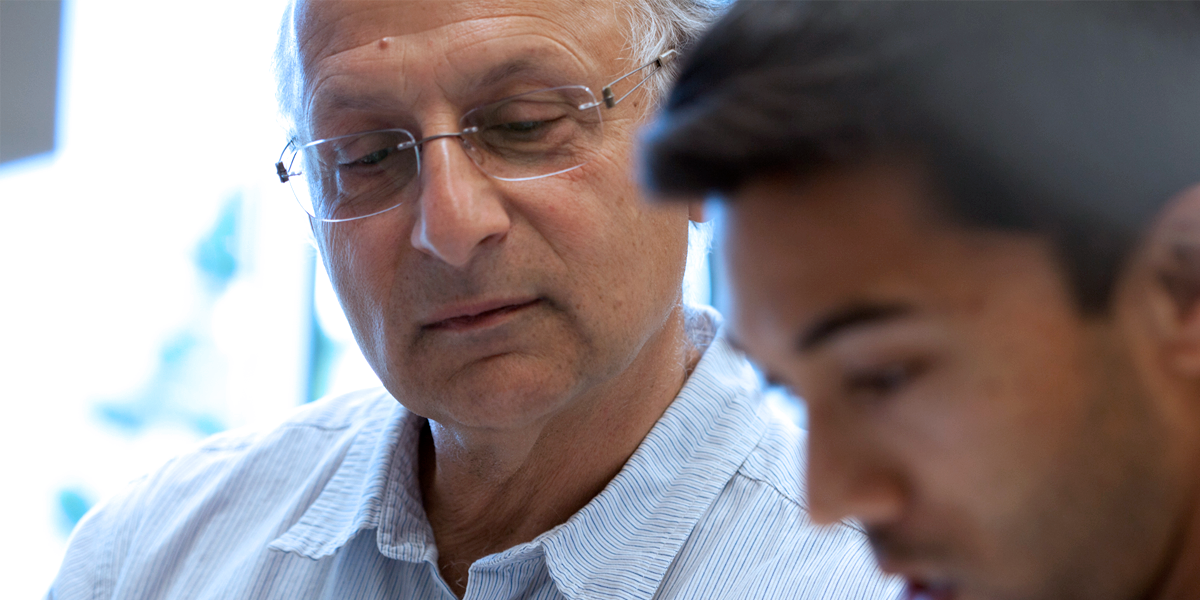The cancer machine
Ludwig understands that basic research sets the stage for big breakthroughs.
The origins of cancer lie in altered DNA. A tumor typically begins when a single cell in the body loses control and its DNA becomes mutated or altered just enough to set off a tailspin of uncontrolled cell division. The damage accumulates—chromosomes snap, some genes break and other genes ramp up their activity—and the tumor expands.
Few researchers understand the connection between DNA damage and cancer as well as Richard Kolodner, a Ludwig scientist in San Diego.
Several years ago, Kolodner’s group homed in on a set of proteins that help keep DNA intact. These proteins repair certain types of DNA damage, dubbed mismatches. Mismatches can arise when DNA is duplicated during cell division—such as when a cell mistakenly adds an “A” when it should add a “T” to a growing DNA strand. Mutations can result if the damage is not repaired correctly. The repair system, called DNA mismatch repair, is essential for fending off cancer. When this system breaks down, cells can tip toward becoming cancerous.
Kolodner’s research showed in 1993 that defects in mismatch repair underlie a common type of inherited cancer, Lynch syndrome, also called hereditary nonpolyposis colorectal cancer. People with this condition are at extremely high risk of developing a variety of cancers, from colorectal to endometrial cancer. He’s also found that defects in the mismatch repair system often arise in sporadic or noninherited tumors, leading to DNA damage that drives the development of these cancers.
“Drawing a connection between DNA mismatch repair and cancer was a big surprise at the time,” says Kolodner. He explains that researchers had suspected that DNA repair defects might be involved in cancer, but they did not expect the defects would have such a big impact, underlying common forms of cancer and a prevalent form of inherited cancer susceptibility.
Despite its central role in cancer, little is known about how the mismatch repair machinery operates. Kolodner asks, “How do the repair proteins find the error they have to fix? How do they access DNA, which is compacted into a tight structure in the cell?”
In two major studies last year, Kolodner’s group began to answer such questions with research that took a close look at the guts of the repair machine. The interactions among the proteins, like the parts of any machine, are intricate. But the findings boil down to this: certain proteins involved in DNA mismatch repair are associated with DNA as it replicates. That means the proteins are in the right place to find mispaired bases in the DNA as they arise, when the DNA loses its compact structure during replication. “The machinery is there at the right place at the right time,” says Kolodner.
To show this, the researchers genetically tinkered with the machinery in yeast cells, which have a similar repair mechanism to that in people, but are more amenable to experimentation. They attached the repair proteins to fluorescent molecules that glowed when examined under a microscope.
In Cell, they report that the proteins were associated with DNA during DNA replication. In another study, published in Science, the researchers engineered the proteins so they were produced only at certain times during the cell’s life cycle. With this technique, they found that the proteins could operate only during DNA replication.
The findings tie DNA mismatch repair to DNA replication and pave the way for future experiments. The researchers, for instance, have now purified each of the proteins required for DNA mismatch repair and are busy reconstituting the process in a test tube. They are also examining the broken mismatch repair machinery in cancer cells to see if it works in a way that would respond to correction by a drug.
Kolodner’s group is not the only one at Ludwig focused on the basic mechanisms of DNA repair. In 2011, Thomas Perlmann, a Ludwig scientist based in Stockholm, discovered a key component of another major DNA repair machine. It fixes double-stranded breaks, in which both strands of adjacent DNA break, slicing apart chromosomes—a common occurrence in cancer.
Kolodner is grateful that the Ludwig Institute understands that basic research sets the stage for big breakthroughs. “These are very complex, very difficult experiments that take a long time to do and a really long time to do well,” he says of his work on DNA mismatch repair.
“I always feel I am privileged to be at Ludwig, because they provide me with the resources to do experiments to the standard that is required to get to definitive answers,” Kolodner says.
